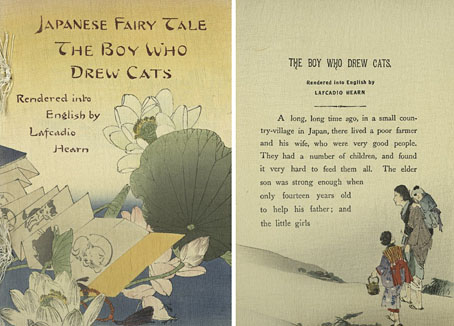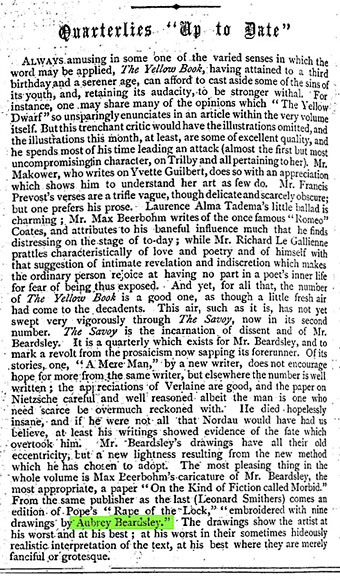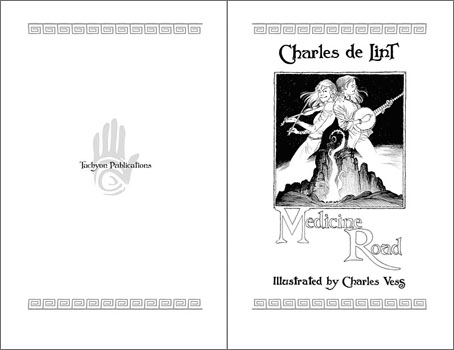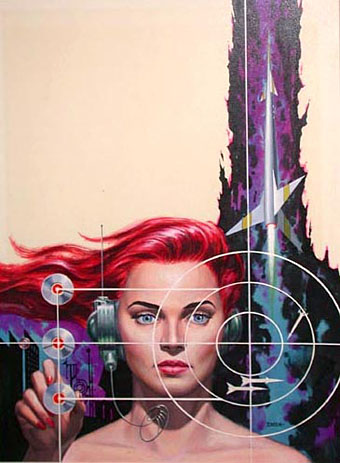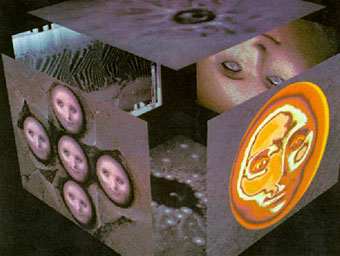The Untied States of America | New film and theatre projects from Adam Curtis.
Category: {art}
Art
The Boy Who Drew Cats
An illustrated book from circa 1926 at the NYPL Digital Gallery. Art by T Hasegawa, words by Lafcadio Hearn.
Elsewhere on { feuilleton }
• The illustrators archive
Previously on { feuilleton }
• 8 out of 10 cats prefer absinthe
• Monsieur Chat
Merely fanciful or grotesque
Thus the judgement of a reviewer examining Aubrey Beardsley’s work in The Graphic for May 23, 1896. The work in question was Beardsley’s Rape of the Lock illustrations being unveiled for the first time in the second number of The Savoy, the magazine which Beardsley co-founded with Arthur Symons and Leonard Smithers as a rival to the staid Yellow Book, also reviewed in the same column. Beardsley’s illustrations for Pope are now considered some of his very finest works and it’s difficult from our perspective to find any grotesquery there at all. It may be a reference to The Cave of Spleen, a drawing which saw the brief return of Beardsley’s earlier foetus creatures and a work to which some of Harry Clarke’s style would seem to owe a debt. In which case the reviewer should have been grateful to be spared the giant phalluses of The Lysistrata which Aubrey was also drawing for Smithers at this time.
The column above is one of many mentions of Beardsley and company to be found at the British Library’s new online archive of 19th century British newspapers. What might be a treasure trove is compromised slightly for me by being a collection of newspapers only, rather than magazines. A magazine database would give us all of The Savoy and The Yellow Book, as well as other titles which featured the work of fin de siècle illustrators. Patience is the key here, with every passing year more of the past becomes easily accessible.
So now, given the quantity of references there’s likely to be, dare I search for Oscar Wilde?
Elsewhere on { feuilleton }
• The Aubrey Beardsley archive
Medicine Road by Charles de Lint
The second of my book designs for Tachyon Publications is published this month and it was good to receive a copy in the same week as getting a load of new CDs. Medicine Road is a contemporary fantasy of shape-shifting and shamanic magic set in the American South West. This job was particularly pleasurable for being illustrated by Charles Vess, celebrated among other things for his many collaborations with Neil Gaiman, including Stardust. I embellished the opening pages with designs based on Native American petroglyphs, a couple of which are from the tribes mentioned in the text.
Laurel and Bess Dillard are charismatic bluegrass musicians enjoying the success of their first Southwestern tour. But the Dillard girls know that magical adventures are always at hand. Upon meeting two mysterious strangers at a gig, the red-headed twins are drawn into a age-old, mystical wager along the Medicine Road.
One day, seeing a red dog chasing a jackalope, Coyote Woman gave them human forms. They became Jim Changing Dog and Alice Corn Hair. In return, both of them must find true love within a hundred years or their “five-fingered” forms will be forfeit. Alice has found her soul mate, but trickster Jim is unwilling to settle down — until he sets eyes upon free-spirited Bess Dillard.
Yet time is running out for the red dog and the jackalope. In just two weeks they will journey to their reckoning at the Medicine Wheel. Meanwhile, a motorcycle-riding seductress and a vengeful rattlesnake woman are eager to meddle, and Bess and Laurel, caught in a web of love and lies, must find their own paths into the spirit world.
Next up from Tachyon will be a book by Kage Baker. More about that later.
Previously on { feuilleton }
• The Best of Michael Moorcock
The art of Ed Emshwiller, 1925–1990
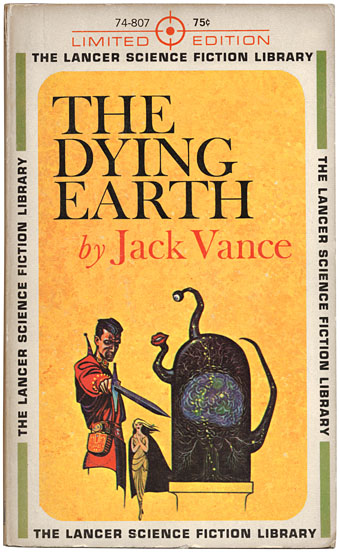
Another item brought to light during the Great Shelf Re-ordering and Spring Clean is this 1962 Lancer paperback of The Dying Earth by Jack Vance, a slim collection of six short connected stories, and another favourite book. Despite the SF label this is far more a work of fantasy (science fantasy, if you must), being tales of the bizarre and occasionally grotesque inhabitants of the last days of the earth. Magic is the order of the day, not advanced technology, although Vance hints that the book’s elaborate spells may be a higher ordering of mathematics capable of manipulating reality. I like the simple cover layout of this edition; Ed Emshwiller’s illustration manages to be sparing yet fully representative of a key scene.
French sf portal Noosfere has recently revamped its artwork showcase and has a substantial collection of Emshwiller’s cover paintings. I’d prefer to see more of his earlier style but the collection includes some striking designs.
Sunstone (1979).
Emshwiller was a very prolific illustrator but from the 1960s on also developed his own style of experimental filmmaking, some examples of which can be found at YouTube. I’d actually seen Sunstone—a very early piece of computer animation—years ago without registering the credit. In addition there’s also Thanatopsis, a strange b&w short which is remarkably similar in tone to some of the films which William Burroughs and Antony Balch were making at around the same time.
• The genre artist | Jack Vance profiled in the NYT
Elsewhere on { feuilleton }
• The book covers archive
• The illustrators archive
Previously on { feuilleton }
• The King in Yellow
• Ballantine Adult Fantasy covers
• Clark Ashton Smith book covers
• Revenant volumes: Bob Haberfield, New Worlds and others
• The World in 2030
• The art of Virgil Finlay, 1914–1971
• Towers Open Fire

